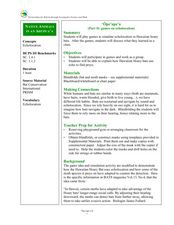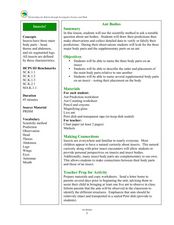McGraw Hill
Stellar Spectroscopy Interactive
Stars seem to be a far away mystery... but it turns out we know much more about stars than one would think! An engaging lesson shows learners how to read a light spectrum to determine the temperature and chemical makeup of a star. They...
NASA
Eclipse Activity Guide
Ever made solar s'mores? Or recreated the solar system using peanuts? Astronomers young and old investigate all things solar using a variety of activities. Explore how the sun works, types of light it emits, and methods of charting the...
Curated OER
Sleuth Rays
Learners conduct a close examination of the atom's electrons, and discover how to theorize the energy levels, observe the brightness of light, classify colors, and measure temperature.
Curated OER
Enlightening Explorations, Part III
Sixth graders continue their examination of light. In groups, they make rainbows and examine the spectrum of visible light. They travel between various stations recording their observations about the behaviors of light. To end the...
Curated OER
Light at the Bottom of the Deep, Dark Ocean?
High schoolers participate in an inquiry activity. They relate the structure of an appendage to its function. They describe how a deepwater organism to its environment without bright light.
Curated OER
Water Works Wonders
Students examine where water is found in the world, how we use it, and the various forms it takes. They observe the refraction of light through a prism, record the day and night sky over a week's time, and create a topographic model of...
Science 4 Inquiry
It's Not All Visible
Electromagnetic waves travel though empty space, something no other wave type can accomplish. Young scientists learn more about the entire spectrum of electromagnetic waves. They sort cards and apply their knowledge to create models of...
Curated OER
Color
Students study the elements of color in paint and light. In this color science lesson, students discuss colors in their world, white light, and rainbows. Students mix three primary paint colors to make various secondary colors. Students...
Curated OER
What You See Is What You Get
Students explore light and colors. They see how white light is made up of various colors. They need to have some background knowledge about prisms, light wave lengths, and behavior of light, primary and secondary colors, and ratios.
Curated OER
Tonnage - Measurement
Students explore the size of one ton. They research the capacity of sialing ships and estimate the volume of rectangular prisms. Students perform activities to discover the capacity of a classroom in tons.
TryEngineering
Exploring at the Nanoscale
Discover a world too small to see. In the lesson, young scientists learn about nanotechnology and brainstorm ideas for new applications of it. They perform an activity to determine how surface area changes when objects are made smaller...
TryEngineering
Sugar Crystal Challenge
Be sure to use this sweet resource. Scholars perform an experiment using sugar to investigate how surface area relates to the coarseness of sugar. They consider how this concept connects to nanotechnology.
Curated OER
Revise Identifying 3-D Shapes
In this 3-D shapes worksheet, students practice identifying 8 3-D shapes with their following precise names: cube, cuboid, square based pyramid, cone, cylinder, tetrahedron, octagonal prism and hexagonal prism.
Curated OER
Games on Echolocation
Get a little batty with life science! This fun simulation game replicates how bats use echolocation to hunt moths in their native Hawaiian habitat. After creating blind folds and discussing some basic principles of echolocation, students...
Curated OER
Ways to See the Sun
Young scholars examine how the regions of the Sun are studied using spectroscopy. They investigate the electromagnetic spectrum and the types of radiation that are associated with it. They use prisms and CD's to examine the light...
Curated OER
Insects and Bugs
Students recognize the difference between insects and bugs while making connections to personal experiences. In this insect and bug instructional activity, students complete a pre-assessment to demonstrate prior knowledge, then gather...
Curated OER
Ant Bodies
Students name the three parts that comprise an insect body. In this ant lesson plan, students make connections regarding the curiosity of insects as it touches upon the students' personal perspectives. Students then observe ants in class...
University of Hawaiʻi
Taxonomy and Me!
Taxonomy is the study of organisms and how you phylum. Three biology activities are included, helping scholars understand four of the six kingdoms, specifically Protista, Plantae, Fungi, and Animalia. Scholars observe and classify in...
Curated OER
Stellar Spectral Fingerprints
Students listen as the teacher introduces Newton's early discovery of the diffraction of light. They use multiple sources of light (fluorescent, incandescent, sunlight, etc) to bend the light. They first use a prism then a diffraction...
Curated OER
Energy Forms
Students explore energy by participating in a science lab in class. In this energy form activity, students define the different types of energy such as light, mechanical and sound while examining energy measuring tools in class. Students...
Curated OER
How Big Is A Humpback Whale?
Learners explore humpback whales. In this humpback whale lesson, students determine the actual size of humpback whales and use diagrams to identify the major features of the humpback whale.
Curated OER
Energy Flow and the Food Chain
Students complete discussions and worksheets about the Hawaiian food chain. In this food chain lesson plan, students research decomposers, consumers, and producers.
Curated OER
Hawaii's Sandy Shores
Investigate Hawaii's sandy shore ecosystem! Start by creating a vocabulary list and having your class complete a KWL chart. Next, pass out the "I think of" sheet. Each learner will then choose a word from a beach bucket and add it to...
Curated OER
"Lettuce" Learn About the Water Cycle
Young scientists investigate the water cycle through a lettuce seed experiment. For this experiment, learners plant lettuce seeds inside of a ziplock bag in order to create a small greenhouse. They observe condensation and precipitation,...
Other popular searches
- Volume of Prisms
- Rectangular Prisms
- Volume of Rectangular Prisms
- Prisms and Pyramids
- Surface Area of Prisms
- Rectangular Prisms Nets
- Identify Prisms and Pyramids
- Triangular Prisms
- Volume of Prisms Cylinders
- Volume Prisms
- Volume Rectangular Prisms
- Volume of Triangular Prisms

























